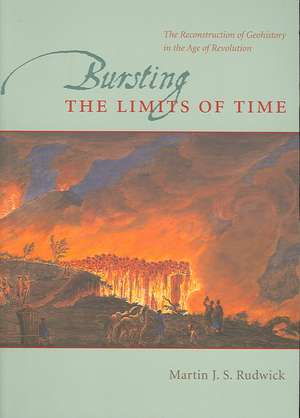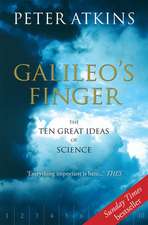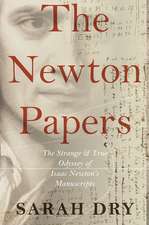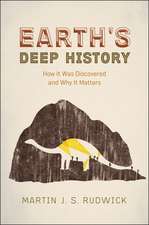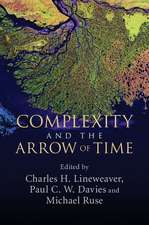Bursting the Limits of Time – The Reconstruction of Geohistory in the Age of Revolution
Autor Martin J. S. Rudwicken Limba Engleză Paperback – 7 mai 2007
During a revolution of discovery in the late eighteenth and early nineteenth centuries, geologists reconstructed the immensely long history of the earth—and the relatively recent arrival of human life. Bursting the Limits of Time is a herculean effort by one of the world's foremost experts on the history of geology and paleontology to illuminate this scientific breakthrough that radically altered existing perceptions of a human's place in the universe as much as the theories of Copernicus and Darwin did.
Rudwick examines here the ideas and practices of earth scientists throughout the Western world to show how the story of what we now call "deep time" was pieced together. He explores who was responsible for the discovery of the earth's history, refutes the concept of a rift between science and religion in dating the earth, and details how the study of the history of the earth helped define a new branch of science called geology.
Bursting the Limits of Time is the first detailed account of this monumental phase in the history of science.
“Bursting the Limits of Time is a massive work and is quite simply a masterpiece of science history. . . . The book should be obligatory for every geology and history of science library, and is a highly recommended companion for every civilized geologist who can carry an extra 2.4 kg in his rucksack.”—Stephen Moorbath, Nature
Rudwick examines here the ideas and practices of earth scientists throughout the Western world to show how the story of what we now call "deep time" was pieced together. He explores who was responsible for the discovery of the earth's history, refutes the concept of a rift between science and religion in dating the earth, and details how the study of the history of the earth helped define a new branch of science called geology.
Bursting the Limits of Time is the first detailed account of this monumental phase in the history of science.
“Bursting the Limits of Time is a massive work and is quite simply a masterpiece of science history. . . . The book should be obligatory for every geology and history of science library, and is a highly recommended companion for every civilized geologist who can carry an extra 2.4 kg in his rucksack.”—Stephen Moorbath, Nature
Preț: 346.17 lei
Nou
Puncte Express: 519
Preț estimativ în valută:
66.25€ • 69.88$ • 55.37£
66.25€ • 69.88$ • 55.37£
Carte tipărită la comandă
Livrare economică 31 decembrie 24 - 14 ianuarie 25
Preluare comenzi: 021 569.72.76
Specificații
ISBN-13: 9780226731131
ISBN-10: 0226731138
Pagini: 732
Ilustrații: 145 halftones, 34 line drawings
Dimensiuni: 180 x 257 x 53 mm
Greutate: 2.2 kg
Ediția:New ed.
Editura: University of Chicago Press
ISBN-10: 0226731138
Pagini: 732
Ilustrații: 145 halftones, 34 line drawings
Dimensiuni: 180 x 257 x 53 mm
Greutate: 2.2 kg
Ediția:New ed.
Editura: University of Chicago Press
Notă biografică
Martin J. S. Rudwick is research associate in the department of History and Philosophy of Science at the University of Cambridge and professor emeritus of history at the University of California, San Diego. He is the author of The Meaning of Fossils, The Great Devonian Controversy, Scenes from Deep Time, and Georges Cuvier, all published by the University of Chicago Press.
Cuprins
List of illustrations
Acknowledgments
A note on footnotes
Introduction
Time and geohistory—Historical parameters—Historicizing the earth—Text and illustrations—Maps of knowledge
Part one: Understanding the earth
1. Naturalists, philosophers, and others
1.1 A savant on top of the world
First ascents of Mont Blanc—Science on the summit—Return to civilization—Conclusion
1.2 The Republic of Letters and its supporters
Savants, professional and amateur—The Republic of Letters—A variety of supporters—Conclusion
1.3 Places of natural knowledge
Laboratories and museums—Savants in the field—The social life of savants—Scientific publication—Conclusion
1.4 Maps of natural knowledge
The literary and the philosophical—Natural history and natural philosophy—Philosophy and theology—Conclusion
2. Sciences of the earth
2.1 Mineralogy as a science of specimens
Minerals and other fossils—Identification and classification—Fossils of organic origin—Fossil localities—Prize specimens—Conclusion
2.2 Physical geography as a spatial science
Huge solid facts—The primacy of fieldwork—Proxy pictures—Maps as instruments—Conclusion
2.3 Geognosy as a structural science
The mining context—Structures and sequences—Primaries and Secondaries—Sequences of Gebirge—Fossils in geognosy—Conclusion
2.4 Earth physics as a causal science
The “physics” of specimens—The “physics” of physical geography—The “physics” of geognostic structures—The “physics” of rock formations—Conclusion
2.5 The question of time
The short timescale versus eternalism—Volcanoes, valleys, and strata—Estimates of the timescale—Encounters with theologians—Conclusion
3. The theory of the earth
3.1 Geotheory as a scientific genre
The meaning of “geology”—The goals of geotheory—Conclusion
3.2 Buffon’s cooling globe
Buffon’s first geotheory—Nature’s epochs—The earth’s timescale—Conclusion
3.3 De Luc’s worlds ancient and modern
The “Christian philosophe”—De Luc’s binary system—Natural measures of time—Conclusion
3.4 Hutton’s eternal earth machine
A deistic geotheory—Cyclic processes—A theory confirmed by fieldwork—Time and eternity—Conclusion
3.5 The standard model of falling sea levels
The multiplicity of geotheories—Neptunist geotheory—Conclusion
4. Transposing history into the earth
4.1 The varieties of history
The diversification of history—Chronology and biblical history—Chorographers and antiquarians—Herculaneum and Pompeii—Conclusion
4.2 Fossils as nature’s documents
Human history and its natural records—The natural history of fossils—Fossils and the earth’s revolutions—Conclusion
4.3 Volcanoes and nature’s epochs
The making of a physical geographer—The volcanoes of Auvergne—Epochs of volcanic activity—A lake on the site of Paris—Conclusion
4.4 Rock formations as nature’s archives
The volcanoes of Vivarais—Nature’s erudite historian—Censors and critics—Exporting geohistory to Russia—Conclusion
4.5 Global geohistory
Causal processes and geotheories—The place of contingency—Saussure as a geotheorist—De Luc as a geohistorian—Conclusion
5. Problems with fossils
5.1 The ancient world of nature
The deep past as a foreign country?—Fossils and geohistory—Migration and transmutation—Conclusion
5.2 Relics of former seas
Vanished shellfish—Living fossils—Fossil fish and possible whales—Explaining the former world—Conclusion
5.3 Witnesses of former continents
Fossil plants—Large fossil bones—The “Ohio animal”—Giant elks and bears—Conclusion
5.4 The antiquity of man
Humans in geohistory—Texts and bones—History from artifacts—Conclusion
Interlude: From survey to narrative
Part two: Reconstructing geohistory
6. A new science of “geology”?
6.1 Revolutions in nature and society (1789–91)
Meanings of revolution—Blumenbach’s “total revolution”—Montlosier’s continuous revolution—Geotheory as a flourishing genre—Conclusion
6.2 Geotheory as geohistory (1790–93)
De Luc’s new system—A differentiated “former world”—The role of fossil evidence—A critique of Hutton—Conclusion
6.3 Theorizing in a time of trouble (1793–94)
Geotheories and focal problems—Dolomieu’s mega-tsunamis—Dolomieu on the Nile delta—The sciences under the Terror—Conclusion
6.4 Geotheory politicized (1793–95)
De Luc and Blumenbach—Cultured despisers of religion—The politics of Genesis—Conclusion
6.5 “Geology” redefined (1794–97)
The sciences after Thermidor—Desmarest’s survey of geotheories—La Métherie’s geotheory—Saussure’s Agenda—Dolomieu on “geology”—Conclusion
7. Denizens of a former world
7.1 A mushroom in the field of savants (1794–96)
Fossil bones as a focal problem—The young Cuvier—The megatherium—The mammoth—Conclusion
7.2 Cuvier opens his campaign (1797–99)
Cave bears and fossil rhinos—Dolomieu and de Luc as Cuvier’s allies—Cuvier’s research program—Hostile critics—Jefferson’s megalonix—Conclusion
7.3 The Napoleon of fossil bones (1798–1800)
Savants in wartime—Cuvier and the First Consul—Cuvier’s network of informants—Cuvier’s international appeal—Conclusion
7.4 Lamarck’s alternative (1800–1802)
The threat of transformism—The response to Cuvier’s appeal—Mummified animals from Egypt—Lamarck’s Parisian fossils—Conclusion
7.5 Enlarging a fossil menagerie (1802–4)
A peaceful interlude—A cumulative case for extinction—Earlier and stranger mammals—Conclusion
8. Geognosy enriche
Acknowledgments
A note on footnotes
Introduction
Time and geohistory—Historical parameters—Historicizing the earth—Text and illustrations—Maps of knowledge
Part one: Understanding the earth
1. Naturalists, philosophers, and others
1.1 A savant on top of the world
First ascents of Mont Blanc—Science on the summit—Return to civilization—Conclusion
1.2 The Republic of Letters and its supporters
Savants, professional and amateur—The Republic of Letters—A variety of supporters—Conclusion
1.3 Places of natural knowledge
Laboratories and museums—Savants in the field—The social life of savants—Scientific publication—Conclusion
1.4 Maps of natural knowledge
The literary and the philosophical—Natural history and natural philosophy—Philosophy and theology—Conclusion
2. Sciences of the earth
2.1 Mineralogy as a science of specimens
Minerals and other fossils—Identification and classification—Fossils of organic origin—Fossil localities—Prize specimens—Conclusion
2.2 Physical geography as a spatial science
Huge solid facts—The primacy of fieldwork—Proxy pictures—Maps as instruments—Conclusion
2.3 Geognosy as a structural science
The mining context—Structures and sequences—Primaries and Secondaries—Sequences of Gebirge—Fossils in geognosy—Conclusion
2.4 Earth physics as a causal science
The “physics” of specimens—The “physics” of physical geography—The “physics” of geognostic structures—The “physics” of rock formations—Conclusion
2.5 The question of time
The short timescale versus eternalism—Volcanoes, valleys, and strata—Estimates of the timescale—Encounters with theologians—Conclusion
3. The theory of the earth
3.1 Geotheory as a scientific genre
The meaning of “geology”—The goals of geotheory—Conclusion
3.2 Buffon’s cooling globe
Buffon’s first geotheory—Nature’s epochs—The earth’s timescale—Conclusion
3.3 De Luc’s worlds ancient and modern
The “Christian philosophe”—De Luc’s binary system—Natural measures of time—Conclusion
3.4 Hutton’s eternal earth machine
A deistic geotheory—Cyclic processes—A theory confirmed by fieldwork—Time and eternity—Conclusion
3.5 The standard model of falling sea levels
The multiplicity of geotheories—Neptunist geotheory—Conclusion
4. Transposing history into the earth
4.1 The varieties of history
The diversification of history—Chronology and biblical history—Chorographers and antiquarians—Herculaneum and Pompeii—Conclusion
4.2 Fossils as nature’s documents
Human history and its natural records—The natural history of fossils—Fossils and the earth’s revolutions—Conclusion
4.3 Volcanoes and nature’s epochs
The making of a physical geographer—The volcanoes of Auvergne—Epochs of volcanic activity—A lake on the site of Paris—Conclusion
4.4 Rock formations as nature’s archives
The volcanoes of Vivarais—Nature’s erudite historian—Censors and critics—Exporting geohistory to Russia—Conclusion
4.5 Global geohistory
Causal processes and geotheories—The place of contingency—Saussure as a geotheorist—De Luc as a geohistorian—Conclusion
5. Problems with fossils
5.1 The ancient world of nature
The deep past as a foreign country?—Fossils and geohistory—Migration and transmutation—Conclusion
5.2 Relics of former seas
Vanished shellfish—Living fossils—Fossil fish and possible whales—Explaining the former world—Conclusion
5.3 Witnesses of former continents
Fossil plants—Large fossil bones—The “Ohio animal”—Giant elks and bears—Conclusion
5.4 The antiquity of man
Humans in geohistory—Texts and bones—History from artifacts—Conclusion
Interlude: From survey to narrative
Part two: Reconstructing geohistory
6. A new science of “geology”?
6.1 Revolutions in nature and society (1789–91)
Meanings of revolution—Blumenbach’s “total revolution”—Montlosier’s continuous revolution—Geotheory as a flourishing genre—Conclusion
6.2 Geotheory as geohistory (1790–93)
De Luc’s new system—A differentiated “former world”—The role of fossil evidence—A critique of Hutton—Conclusion
6.3 Theorizing in a time of trouble (1793–94)
Geotheories and focal problems—Dolomieu’s mega-tsunamis—Dolomieu on the Nile delta—The sciences under the Terror—Conclusion
6.4 Geotheory politicized (1793–95)
De Luc and Blumenbach—Cultured despisers of religion—The politics of Genesis—Conclusion
6.5 “Geology” redefined (1794–97)
The sciences after Thermidor—Desmarest’s survey of geotheories—La Métherie’s geotheory—Saussure’s Agenda—Dolomieu on “geology”—Conclusion
7. Denizens of a former world
7.1 A mushroom in the field of savants (1794–96)
Fossil bones as a focal problem—The young Cuvier—The megatherium—The mammoth—Conclusion
7.2 Cuvier opens his campaign (1797–99)
Cave bears and fossil rhinos—Dolomieu and de Luc as Cuvier’s allies—Cuvier’s research program—Hostile critics—Jefferson’s megalonix—Conclusion
7.3 The Napoleon of fossil bones (1798–1800)
Savants in wartime—Cuvier and the First Consul—Cuvier’s network of informants—Cuvier’s international appeal—Conclusion
7.4 Lamarck’s alternative (1800–1802)
The threat of transformism—The response to Cuvier’s appeal—Mummified animals from Egypt—Lamarck’s Parisian fossils—Conclusion
7.5 Enlarging a fossil menagerie (1802–4)
A peaceful interlude—A cumulative case for extinction—Earlier and stranger mammals—Conclusion
8. Geognosy enriche
Recenzii
“To describe Rudwick as ‘scholarly’ is rather like describing Mozart as ‘musically talented.' He is omniscient, and it’s greatly to be wished that this book becomes known beyond the ranks of historians of the recondite."
"Bursting the Limits of Time is a massive work and is quite simply a masterpiece of science history. . . . The book should be obligatory for every geology and history of science library, and is a highly recommended companion for every civilized geologist who can carry an extra 2.4 kg in his rucksack."
“The first detailed account of the monumental phase in the history of science, when 18th- and early 19th-century earth scientists gradually pieced together the ideas of what we now call ‘deep time.’”
"A magisterial work...a huge accomplishment—detailed, subtle, refined—and it is difficult to do justice here to the depth and breadth of its argument. It will surely stand as the definitive work on the topic for many years to come."
"This is a masterful study by the world's foremost expert in the history of natural history . . . which deserves to be read by anyone interested in understanding the foundations of the modern historical sciences. . . . A short review cannot possibly do justice to the intricate, erudite, meticulously researched and immensely enjoyable history Rudwick weaves. . . . It is difficult to imagine a more impressive survey of genuinely 'big questions' in the origin of a modern scientific field, or a more appropriate statement of a life's work. . . . In every way, this is a truly magnificent book."
"Martin Rudwick has written a chef d'oeuvre. . . . Bursting the Limits of Time is a monument of the early history of geology that puts all before it in the shade."
"One of the most respected historians of science today, Rudwick has produced a masterfully written, splendidly researched, richly detailed, and superbly illustrated (no less than 175 plates!) work."
"Martin J. S. Rudwick has provided a work of superb scholarship on thought related to processes...Many extensive and well-written passages expose popular mythologies that have resulted from prior oversimplification or distortion to become near dogma in geology and paleobiology. In a spirit of great fairness, by placing now-invalidated concepts into the contexts of the science of the day, Rudwick has defended the viewpoints of many who popularly came to be considered almost as buffoons. He has also shown in several cases how long-unrecognized, faulty translations of the original texts, or even inappropriate editorial alterations in citations, have led to sneeringly negative misrepresentations of individuals’ abilities...Most of the text’s illustrations are taken from archival drawings or maps characteristic of the time. The figures are aesthetically wonderful, well chosen, and their integration in the text is absolutely essential to full understanding of the points being made."
"This well written and richly illustrated book should appeal to historians and geologists alike, and it is indispensable for the historians of stratigraphy."
